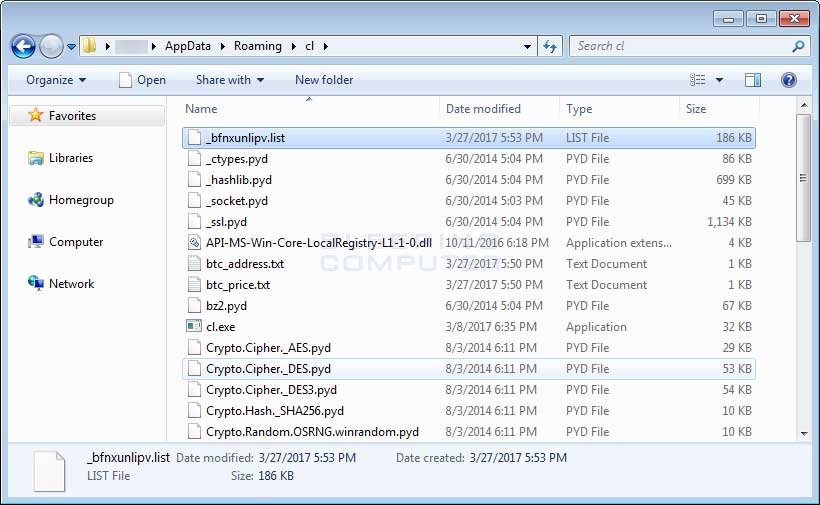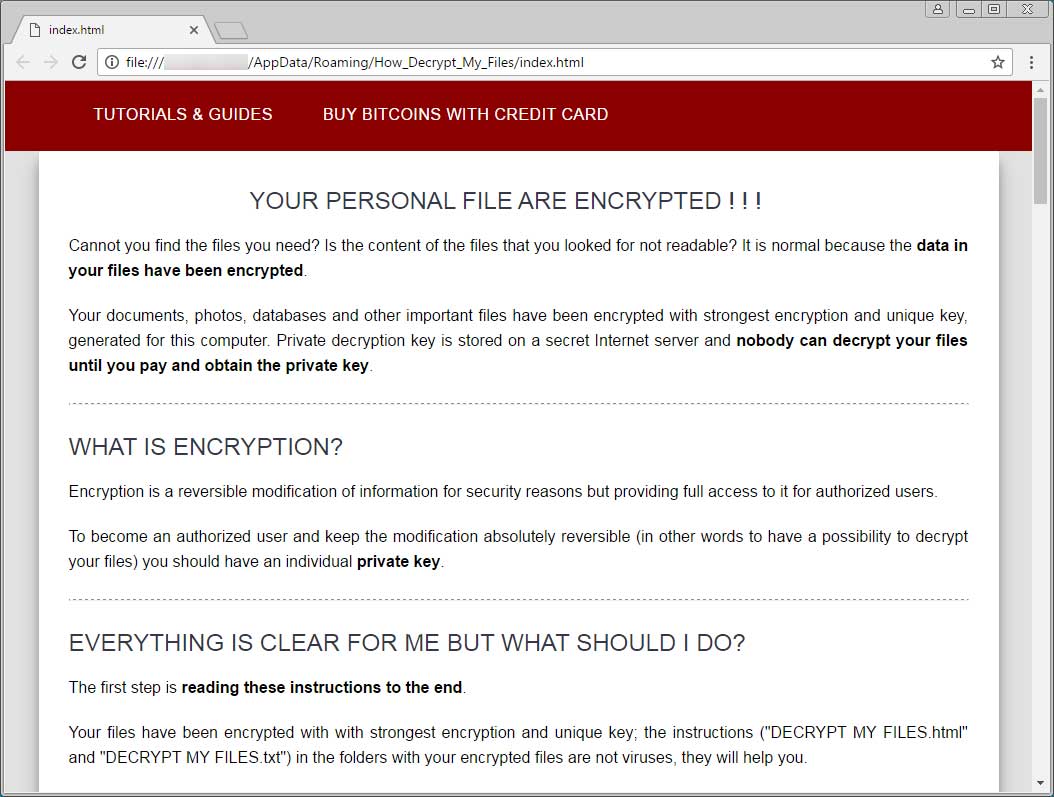This past Saturday security researchers Kafeine, MalwareHunterteam, BroadAnalysis, and David Martínez discovered a new ransomware being distributed through EITest into the RIG exploit kit. As this ransomware was only distributed for one day and does not securely encrypt files, it makes me believe that this may have been a test distribution run.
While the colors and interface used by this ransomware have a striking resemblance to CTB-Locker/Critroni, it is written in a different language and there are no distinguishing strings in the ransom notes or executables. Since it’s programmed in Python and the script is called cl.py, I will be referring to it as PyCL in this article.
PyCL Distributed through EITest and the RIG Exploit Kit
Starting on Saturday, numerous researchers noticed that EITest was pushing visitors to the RIG exploit kit, which was distributing this new PyCL ransomware. This was done through hacked sites that redirected the visitor to RIG, which would then try and exploit vulnerabilities on the computer in order to install the ransomware.

Source: Kafeine
According to Kafeine, EITest was distributing both Cerber and PyCL at the same time. The PyCL distribution, though, only lasted for that one day.
Could PyCL be Part of a RaaS?
One of the files contained in the NSIS installer is a file called user.txt. This file contains the string xkwctmmh, which is sent to the Command & Control server during every request. Furthermore, this same string was also used when David Martínez tested the ransomware.
To me this indicates that this ransomware may be part of an upcoming RaaS, or Ransomware as a Service, where the username is the affiliate identifier.
How the PyCL Ransomware Encrypts a Computer
The PyCL Ransomware is distributed as an NSIS installer that contains a Python package that is used to encrypt a computer and a tutorial on how to pay the ransom. PyCL also communicates back to the Command & Control server at each stage of the process in order to provide debugging/status information to the developer. A full list of network requests can be found at the end of the article.
When the PyCL installer is executed, the tutorial files will be extracted to the %AppData\Roaming\How_Decrypt_My_Files\ folder and the Python components will be extracted to the %AppData%\cl folder.

The installer will then connect to the Command & Control server at 170.254.236.102/status/?status=IS&u=xkwctmmh&sub=1 followed by the launching of the %AppData%\cl\cl.exe executable. CL.exe is actually a Python script compiled into an executable, which will begin to encrypt the computer.
PyCL will first check if the user has administrative privileges, and if they do, will delete the shadow volume copies on the computer using the command:
c:\windows\system32\vssadmin.exe delete shadows /all /quietIt then connects to the C2 server again and sends a POST request to https://170.254.236.102/init/. This POST request will send the victims Windows version, whether the victim has administrative privileges, the screen resolution, processor architecture, computer name, user name, and the mac address of the primary network adapter.
The C2 server will respond with a public RSA-2048 public encryption key, a bitcoin payment address, the ransom amount in bitcoins, and the ransom amount in USD. This information is then saved into the files public_key.txt, btc_address.txt, btc_price.txt, and usd_price.txt in the %AppData%\cl folder.
PyCL will now generate a list of files to encrypt and store this list in the %AppData%\cl\filelist.txt. When generating the list it will skip files located in the following folders:
WINDIR, APPDATA, LOCALAPPDATA, ProgramData, ProgramFiles, PROGRAMW6432, $RECYCLE.BIN, and ProgramFiles(x86)It will then encrypt every file in this list with a unique AES-256 encryption key for each file. The list of files and their respective decryption key is then saved in a random named file in the CL folder. This file is then encrypted using the RSA-2048 public encryption key that was previously received from the C2 server.
At this time, due to the way the ransomware is coded, the original files are not deleted! So while an encrypted copy of your files is created, you still have access to the original unencrypted files.
When completed, it will create a link on the desktop called How Decrypt My Files.lnk that opens the %AppData%\Roaming\How_Decrypt_My_Files\index.html file. This file contains a tutorial on how to pay the ransom and get the files back. A small portion of this ransom note can be seen below. The full version can be viewed here.

PyCL will now execute the UI.exe executable, which will display the lock screen shown below.

This lock screen will contain a 4 day timer, your bitcoin address, and the ransom amount. If you click on the Proceed to Payment button, it will open the ransom note from the C2 server. While running, this lock screen will intermittently check the C2 server to see if a payment has been made to your bitcoin address. If a payment has been made, it will automatically decrypt the files on the computer.
Since this ransomware does not currently delete the original files, those who are infected do not have to worry about losing their files. If this changes, though, the ransomware will be further analyzed for weakness that can be exploited to decrypt files for free.
Files associated with the PyCL Ransomware:
%AppData%\Roaming\cl\
%AppData%\Roaming\cl\API-MS-Win-Core-LocalRegistry-L1-1-0.dll
%AppData%\Roaming\cl\btc_address.txt
%AppData%\Roaming\cl\btc_price.txt
%AppData%\Roaming\cl\bz2.pyd
%AppData%\Roaming\cl\cl.exe
%AppData%\Roaming\cl\Crypto.Cipher._AES.pyd
%AppData%\Roaming\cl\Crypto.Cipher._DES.pyd
%AppData%\Roaming\cl\Crypto.Cipher._DES3.pyd
%AppData%\Roaming\cl\Crypto.Hash._SHA256.pyd
%AppData%\Roaming\cl\Crypto.Random.OSRNG.winrandom.pyd
%AppData%\Roaming\cl\Crypto.Util.strxor.pyd
%AppData%\Roaming\cl\Crypto.Util._counter.pyd
%AppData%\Roaming\cl\filelist.txt
%AppData%\Roaming\cl\library.zip
%AppData%\Roaming\cl\mklnk.cmd
%AppData%\Roaming\cl\public_key.txt
%AppData%\Roaming\cl\pyexpat.pyd
%AppData%\Roaming\cl\python27.dll
%AppData%\Roaming\cl\pywintypes27.dll
%AppData%\Roaming\cl\remove.cmd
%AppData%\Roaming\cl\select.pyd
%AppData%\Roaming\cl\server.txt
%AppData%\Roaming\cl\subid.txt
%AppData%\Roaming\cl\ui.exe
%AppData%\Roaming\cl\unicodedata.pyd
%AppData%\Roaming\cl\usd_price.txt
%AppData%\Roaming\cl\user.txt
%AppData%\Roaming\cl\win32api.pyd
%AppData%\Roaming\cl\win32pdh.pyd
%AppData%\Roaming\cl\win32pipe.pyd
%AppData%\Roaming\cl\win32wnet.pyd
%AppData%\Roaming\cl\_ctypes.pyd
%AppData%\Roaming\cl\_hashlib.pyd
%AppData%\Roaming\cl\_nenrgarxmr.list
%AppData%\Roaming\cl\_socket.pyd
%AppData%\Roaming\cl\_ssl.pyd\
%AppData%\Roaming\How_Decrypt_My_Files\
%AppData%\Roaming\How_Decrypt_My_Files\img\
%AppData%\Roaming\How_Decrypt_My_Files\img\1.png
%AppData%\Roaming\How_Decrypt_My_Files\img\2.png
%AppData%\Roaming\How_Decrypt_My_Files\img\4.png
%AppData%\Roaming\How_Decrypt_My_Files\img\5.png
%AppData%\Roaming\How_Decrypt_My_Files\img\6.png
%AppData%\Roaming\How_Decrypt_My_Files\img\arrow.png
%AppData%\Roaming\How_Decrypt_My_Files\img\bitpanda.png
%AppData%\Roaming\How_Decrypt_My_Files\img\blockchain-send1.jpg
%AppData%\Roaming\How_Decrypt_My_Files\img\blockchain-send2.jpg
%AppData%\Roaming\How_Decrypt_My_Files\img\blockchain-send3.png
%AppData%\Roaming\How_Decrypt_My_Files\img\cex.png
%AppData%\Roaming\How_Decrypt_My_Files\img\coinbase.png
%AppData%\Roaming\How_Decrypt_My_Files\img\coinhouse.png
%AppData%\Roaming\How_Decrypt_My_Files\img\coinmama.png
%AppData%\Roaming\How_Decrypt_My_Files\img\exchange.png
%AppData%\Roaming\How_Decrypt_My_Files\img\help.png
%AppData%\Roaming\How_Decrypt_My_Files\img\ui_main.jpg
%AppData%\Roaming\How_Decrypt_My_Files\img\ui_main_end.jpg
%AppData%\Roaming\How_Decrypt_My_Files\img\warning.png
%AppData%\Roaming\How_Decrypt_My_Files\index.html
%AppData%\Roaming\How_Decrypt_My_Files\pay_creditcard.html
%AppData%\Roaming\How_Decrypt_My_Files\read_me.txt
%AppData%\Roaming\How_Decrypt_My_Files\send_btc.html
%AppData%\Roaming\How_Decrypt_My_Files\style.css
%UserProfile%\Desktop\How Decrypt My Files.lnkRegistry entries associated with the PyCL Ransomware:
HKCU\Software\Microsoft\Windows\CurrentVersion\Run\cl %AppData%\Roaming\cl\cl.exeHashes of Main Components:
Installer: 80d402f38ff9849ea5e9f8a126e00f423ca1b4f1121c8059aebed8336bfc6f30
CL.exe: fc2f4904fa71ec4c1e3c73cbac03a57d701409634e3a8a23b05d15edca28d7de
UI.exe: b01d1230f31200a5f195b7f44fcc552a71b9bfe131f7b8eccd2466eb66a952dcNetwork Communication:
https://170.254.236.102/status/?status=IS&u=xkwctmmh&sub=1 - Issues by NSIS Installer
https://170.254.236.102/init/ - On Execution of CL.exe to retrieve key and other info
https://170.254.236.102/status/?status=FS&btc=[bitcoin_address]&u=xkwctmmh&sub=1 - Begin generating list of files to encrypt.
https://170.254.236.102/status/?status=FC&btc=[bitcoin_address]&u=xkwctmmh&sub=1 - End generating list
https://170.254.236.102/status/?status=ES&btc=[bitcoin_address]&u=xkwctmmh&sub=1 - Begin Encrypting Files
https://170.254.236.102/status/?status=EC&btc=[bitcoin_address]&u=xkwctmmh&sub=1 - End Encrypting Files
https://170.254.236.102/get_private_key/?btc=[bitcoin_address] - Check if payment has been made
https://170.254.236.102/status/?status=DS&btc=[bitcoin_address]&u=xkwctmmh&sub=1 - Begin Decrypting
https://170.254.236.102/status/?status=DC&btc=[bitcoin_address]&u=xkwctmmh&sub=1 - End Decrypting
https://170.254.236.102/help/?btc=[bitcoin_address] - Online tutorialPyCL Lock Screen Text:
Your Personal Files Are Encrypted
Your documents, photos, databases and other important files have been encrypted with strongest encryption and unique key, generated for this computer. Private decryption key is stored on a secret Internet server and nobody can decrypt your files until you pay and obtain the private key.
1. Pay amount BTC (about of USD) to address:
2. Transaction will take about 15-30 minutes to confirm.
Decryption will start automatically. Do not: power off computer, run antivirus program, disable internet connection. Failures during key recovery and file decryption may lead to accidental damage on files.
Your files will be lost without payment through:Source:https://www.bleepingcomputer.com

Working as a cyber security solutions architect, Alisa focuses on application and network security. Before joining us she held a cyber security researcher positions within a variety of cyber security start-ups. She also experience in different industry domains like finance, healthcare and consumer products.










